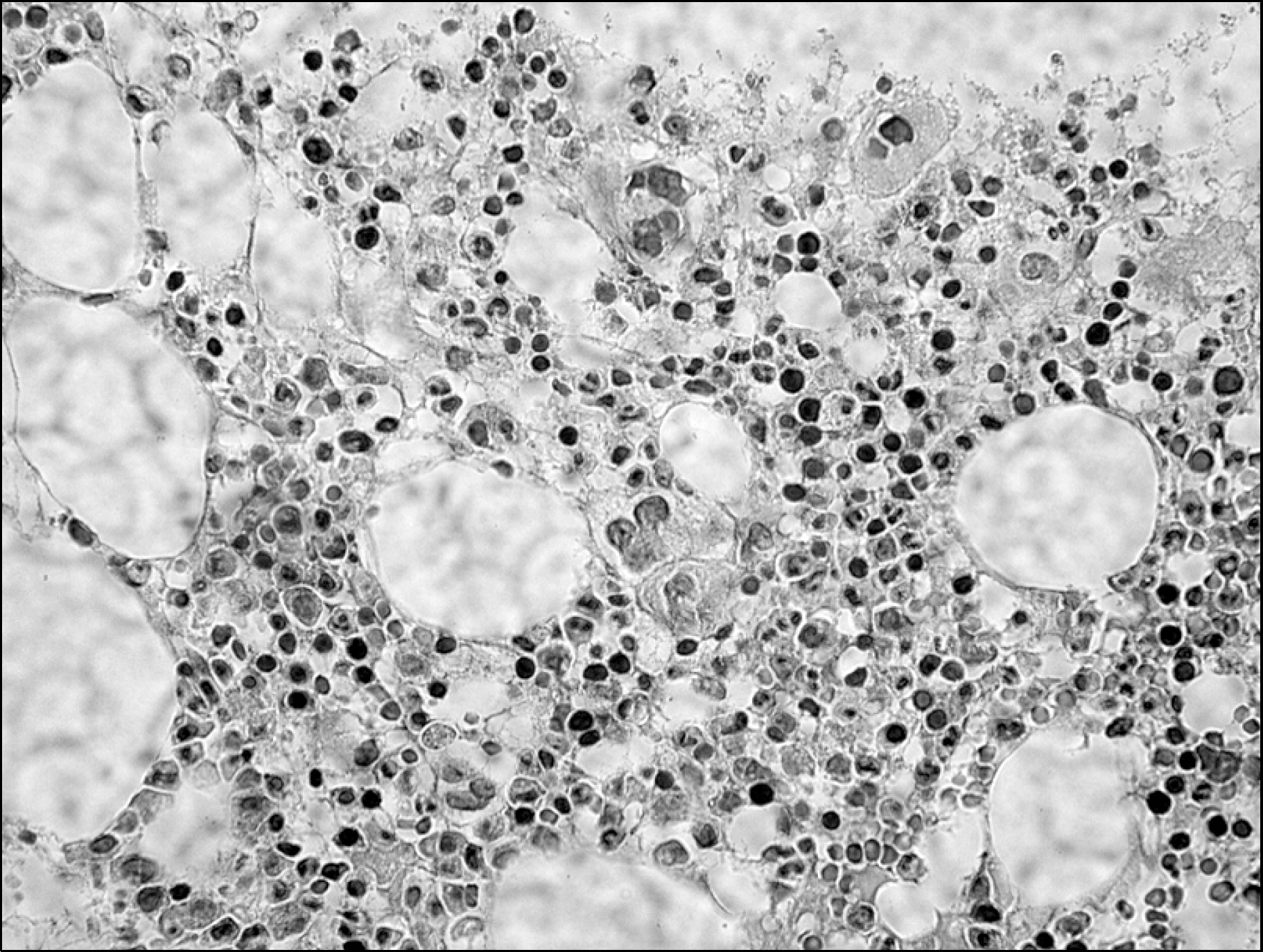Korean J Hematol.
2009 Jun;44(2):113-116. 10.5045/kjh.2009.44.2.113.
A Case of Immune Thrombocytopenic Purpura Developing after Treatment for Non-Hodgkin's Lymphoma
- Affiliations
-
- 1Department of Internal Medicine, College of Medicine, Kangwon National University, Chuncheon, Korea. sysong@kangwon.ac.kr
- 2Department of Laboratory Medicine, College of Medicine, Kangwon National University, Chuncheon, Korea.
- KMID: 2252157
- DOI: http://doi.org/10.5045/kjh.2009.44.2.113
Abstract
- Immune thrombocytopenic purpura (ITP) can be classified as primary or secondary according to the presence of an underlying non-malignant or malignant disorder, including lymphoproliferative disorders. The estimated prevalence of ITP in patients with Hodgkin's lymphoma is about 1%, and its clinical course has been reported in approximately 50 patients. ITP is an unusual and poorly documented complication in patients with non-Hodgkin's lymphoma. Some cases have been described in patients who have undergone high-dose chemotherapy and autologous bone marrow/peripheral blood stem cell transplantation. Rare cases appear to be coincidental. Here, we report on a rare case of a 61-year-old man who had ITP after being in a state of complete remission of non-Hodgkin's lymphoma for about 15 months.
MeSH Terms
Figure
Reference
-
References
1. Hauswirth AW, Skrabs C, Schützinger C, et al. Autoimmune thrombocytopenia in non-Hodgkin's lymphomas. Hematologica. 2008; 93:447–50.
Article2. Liebman H. Other immune thrombocytopenias. Semin Hematol. 2007; 44:S24–S34.
Article3. Kirshner JJ, Zamkoff KW, Gottlieb AJ. Idiopathic thrombocytopenia purpura and Hodgkin's disease: report of two cases and a review of the literature. Am J Med Sci. 1980; 280:21–8.4. Cohen JR. Idiopathic thrombocytopenic purpura in Hodgkin's disease: a rare occurrence of no prognostic significance. Cancer. 1978; 41:743–6.5. Jones SE. Autoimmune disorders and malignant lymphoma. Cancer. 1973; 31:1092–8.
Article6. Kaden BR, Rosse WF, Hauch TW. Immune thrombocytopenia in lymphoproliferative disease. Blood. 1979; 53:545–51.7. Gang MS, Kim SW, Kim JS, et al. Immune thrombocytopenic purpura. Cha YJ, Goo HH, Gwon SW, editors. Hematology. 1st ed.Seoul, Korea: Epublic Press;2006. p. 497–503.8. Hamblin TJ, Oscier DG, Young BJ. Autoimmunity in chronic lymphocytic leukaemia. J Clin Pathol. 1986; 39:713–6.
Article9. Váróczy L, Gergely L, Zeher M, Szegedi G, Illés A. Malignant lymphoma-associated autoimmune diseases-a descriptive epidemiological study. Rheumatol Int. 2002; 22:233–7.10. Dührsen U, Augener W, Zwingers T, Brittinger G. Spectrum and frequency of autoimmune derangements in lymphoproliferative disorders: analysis of 637 cases and comparison with myeloproliferative diseases. Br J Haematol. 1987; 67:235–9.
Article11. Gr⊘nbaek K, D'Amore F, Schmidt K. Autoimmune phenomena in non-Hodgkin's lymphoma. Leuk Lymphoma. 1995; 18:311–6.12. Diehl LF, Ketchum LH. Autoimmune disease and chronic lymphocytic leukemia: autoimmune hemolytic anemia, pure red cell aplasia, and autoimmune thrombocytopenia. Semin Oncol. 1998; 25:80–97.13. Cooper N, Bussel J. The pathogenesis of immune thrombocytopaenic purpura. Br J Haematol. 2006; 133:364–74.
Article
- Full Text Links
- Actions
-
Cited
- CITED
-
- Close
- Share
- Similar articles
-
- A Case of Immune Thrombocytopenic Purpura with Helicobacter Pylori Infection
- Treatment of Immue Thrombocytopenic Purpura in Childhood
- A Case of Non-Hodgkin's Lymphoma in Patient with Coombs' Negative Hemolytic Anemia and Idiopathic Thrombocytopenic Purpura
- Immune Thrombocytopenic Purpur and Neutropenia Associatedwith Ulcerative Colitis
- Diagnosis and treatment of purpura





